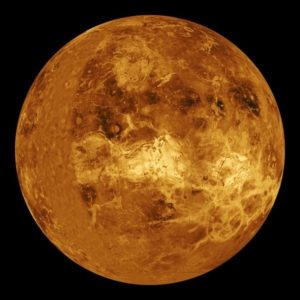Venus
Sometimes called our sister planet, despite similar properties, this “sibling” is nothing like Earth.

This computer-simulated Venus globe contains data from several spacecraft: Magellan; Venera 13, 14, 15, and 16; and the Pioneer Venus Orbiter. Additional Earth-based data from Arecibo fill in some of the gaps.
NASA/JPL
The planet Venus is just 1.1 times smaller than Earth. It lies slightly closer to the Sun (0.7 versus 1 AU), with a similar volume and density to our home. But our so-called sister planet is a harsh, unforgiving place where even our hardiest spacecraft haven’t survived more than a few hours on the surface before experiencing complete system failure.
Venus is enshrouded by a thick atmosphere of carbon dioxide. Beneath sulfuric acid clouds, the planet experiences the greenhouse effect gone wild, with surface temperatures climbing above 880 degrees Fahrenheit (470 degrees Celsius). Not only is the ground a gloomy, hazy place, it’s also akin to standing a full mile (1.6 kilometers) under the ocean on Earth, thanks to the immense pressure exerted by the planet’s heavier atmosphere.
The planet is also an oddball among its solar system brethren save one: of the planets that circle our Sun, only Venus and Uranus rotate retrograde, or backwards relative to the direction of their orbits around the Sun. Even stranger, the year on Venus is shorter than its day: Venus circles the Sun once every 225 Earth days, but it takes 243 days to rotate once on its axis. Furthermore, based on observations taken by different spacecraft over a decade apart, astronomers have determined that Venus is slowing down — over the course of 16 years, its day lengthened by about 6.5 minutes.
Despite its oddities and its harsh conditions, Venus remains a mysterious place that beckons us to return and explore.
